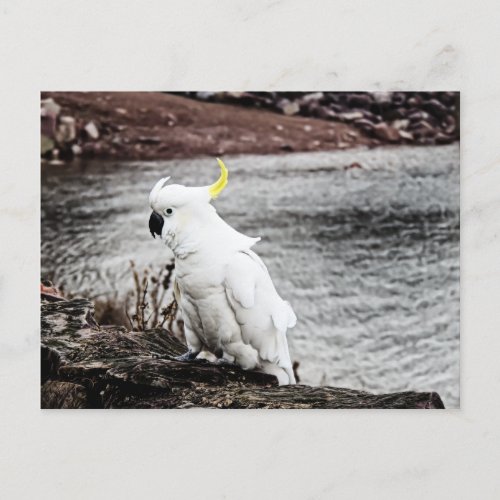Sulphur-Crested Cockatoo Postcard



Sulphur-Crested Cockatoo (Cacatua galerita) resting near Lake Bellfield, Grampians National Park near Halls Gap, Victoria (Australia) From Wikipedia: The sulphur-crested cockatoo (Cacatua galerita) is a relatively large white cockatoo found in wooded habitats in Australia and New Guinea and some of the islands of Indonesia. It has a total length of 44–55 cm (17.5–21.5 in), with the Australian subspecies larger than subspecies from New Guinea and nearby islands. The plumage is overall white, while the underwing and -tail are tinged yellow. The expressive crest is yellow. The bill is black, the legs are grey, and the eye-ring is whitish. Males typically have almost black eyes, whereas the females have a more red or brown eye, but this requires optimum viewing conditions to be seen. The differences between the subspecies are subtle. C. g. fitzroyi is similar to the nominate race but lacks the yellow on the ear tufts and has slightly blueish skin around the eye. C. g. eleonora is similar to C. g. fitzroyi but is smaller and has broader feathers in the crest, and C. g. triton is similar to C. g. eleonora except it has a smaller bill. Their distinctive raucous call can be very loud; it is adapted to travel through the forest environments in which they live, including tropical and subtropical rainforests. These birds are naturally curious, as well as very intelligent. They have adapted very well to European settlement in Australia and live in many urban areas. These birds are very long-lived, and can live upwards of 70 years in captivity,[3][4] although they only live to about 20–40 years in the wild. They have been known to engage in geophagy, the process of eating clay to detoxify their food. These birds produce a very fine powder to waterproof themselves instead of oil as many other birds do. The sulphur-crested cockatoo is a seasonal breeder in Australia; little is known about its breeding behaviour in New Guinea. In southern Australia the breeding season is from August to January, whereas in northern Australia the season is from May to September. The nest is a bed of wood chips in a hollow in a tree. Like many other parrots it competes with others of its species and with other species for nesting sites. Two to three eggs are laid and incubation lasts between 25–27 days. Both parents incubate the eggs and raise the nestlings. The nestling period is between 9 and 12 weeks, and the young fledglings remain with their parents for a number of months after fledging. A 2009 study involving an Eleonora cockatoo (the subspecies Cacatua galerita eleonora) named Snowball found that sulphur-crested cockatoos are capable of synchronising movements to a musical beat. Species that feed on the ground are very vulnerable to predator attack. The cockatoo has evolved a behavioural adaptation to protect against this: whenever there is a flock on the ground, there is at least one high up in a tree (usually a dead tree), keeping guard. This is so well known that it has even entered Australian slang: a person keeping guard for sudden police raids on illegal gambling gatherings is referred to as a cockatoo or cocky for short.


